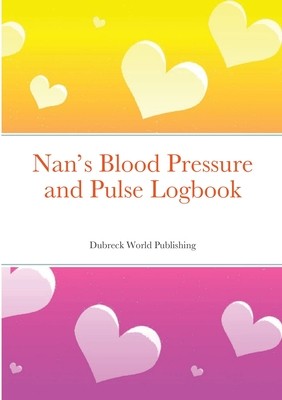
- We will send in 10–14 business days.
- Author: Dubreck World Publishing
- Publisher: Lulu.com
- ISBN-10: 1105711595
- ISBN-13: 9781105711596
- Format: 14.8 x 21 x 0.8 cm, softcover
- Language: English
- SAVE -10% with code: EXTRA
Reviews
Description
A special gift for Nan! Regularly record your blood pressure and pulse in this handy and easy to use logbook and take it with you to your next doctor or nurse appointment. This will help them see your overall progress and consider if any adjustment to your treatment may be necessary. Record your blood pressure as often as you are advised to by a qualified medical practitioner. Taking your blood pressure is a way of measuring the strength with which the blood pushes the sides of your arteries as the heart pumps it around your body. Checking your blood pressure will show you if it is high (hypertension), normal, or low (hypotension). Low blood pressure can cause dizziness and fainting, and long term high blood pressure can cause serious complications. If you suffer with high hypertension, your medical practitioner may advise you to regularly check your blood pressure and record your results. 30 minutes before checking your blood pressure, don't exercise, smoke, drink caffeine or eat a big meal as these may elevate your results. You should also empty your bladder at least five minutes before taking a reading. Try and measure your blood pressure at the same times each day and take two or three readings each time, one minute apart and then log each reading in your log book. When you take your blood pressure, you will have two readings. The systolic number is the higher number. This measures the pressure of the blood in your arteries when your heart beats. The diastolic number is the lower number. This measures the pressure of the blood in your arteries when your heart rests in between beats. Monitoring and logging your readings in this journal will allow you and your doctor to spot patterns of rising hypertension and enable appropriate medical intervention to avoid serious complications that could risk your life.
- Author: Dubreck World Publishing
- Publisher: Lulu.com
- ISBN-10: 1105711595
- ISBN-13: 9781105711596
- Format: 14.8 x 21 x 0.8 cm, softcover
- Language: English English
A special gift for Nan! Regularly record your blood pressure and pulse in this handy and easy to use logbook and take it with you to your next doctor or nurse appointment. This will help them see your overall progress and consider if any adjustment to your treatment may be necessary. Record your blood pressure as often as you are advised to by a qualified medical practitioner. Taking your blood pressure is a way of measuring the strength with which the blood pushes the sides of your arteries as the heart pumps it around your body. Checking your blood pressure will show you if it is high (hypertension), normal, or low (hypotension). Low blood pressure can cause dizziness and fainting, and long term high blood pressure can cause serious complications. If you suffer with high hypertension, your medical practitioner may advise you to regularly check your blood pressure and record your results. 30 minutes before checking your blood pressure, don't exercise, smoke, drink caffeine or eat a big meal as these may elevate your results. You should also empty your bladder at least five minutes before taking a reading. Try and measure your blood pressure at the same times each day and take two or three readings each time, one minute apart and then log each reading in your log book. When you take your blood pressure, you will have two readings. The systolic number is the higher number. This measures the pressure of the blood in your arteries when your heart beats. The diastolic number is the lower number. This measures the pressure of the blood in your arteries when your heart rests in between beats. Monitoring and logging your readings in this journal will allow you and your doctor to spot patterns of rising hypertension and enable appropriate medical intervention to avoid serious complications that could risk your life.


Reviews